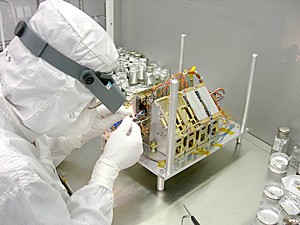The UA’s Lunar and Planetary Laboratory, which usually faces obstacles like operating cameras from millions of miles away, could be up against an even bigger foe: federal budget cuts.
The proposed $2.77 trillion federal budget, released last week, reallocated more than $3 billion away from space science research over five years, said Michael Drake, director of the Lunar and Planetary Laboratory.
The fiscal year 2007 proposed budget released last week deferred money from the robotic space exploration division to the International Space Station and NASA’s space shuttle replacement programs.
If this budget proposal were to go into effect, it could mean bad news to the UA’s robotic unmanned space program, Drake said.
“”Science is being raided to complete the space station,”” Drake said.
The UA is one of the national leaders in the field of robotic space exploration, receiving much of its funding from the NASA budget, he said.
“”More funds flow to us than anybody else,”” Drake said.
The deferment of funds is in response to President Bush’s Visions for Space Exploration plan, which includes returning Americans to the moon.
Drake said the issue is not with the plan itself, but the money budgeted to it.
“”The problem is the president has not requested an adequate budget to fund this endeavor,”” Drake said.
NASA has the difficult task of shuffling the proposed $16.8 billion around to fund all its projects, Drake said.
“”One plain fact is NASA simply cannot afford to do everything that our many constituencies would like us to do,”” NASA Administrator Michael Griffin said in a statement last week. “”We must set priorities, and we must adjust our spending to match those priorities.””
Drake anticipates stiff resistance to the budget proposal, which is expected to be finalized by Congress sometime before the Oct. 1 deadline.
“”Needless to say, we’re not going to take this lying down,”” Drake said.
Based on the discussion about the topic, Congress will have the final say in how much money to allocate to the NASA budget.
“”I have long supported federal funding for space research and exploration programs,”” said Congressman Jim Kolbe in an e-mail to the Arizona Daily Wildcat. “”It is important to remember the President’s budget request is just that – a request. Congress will look at all funding levels for programs to determine the appropriate funding based on this year’s budget constraints.””
Current Mars missions unharmed
While future robotic projects could be affected by a budget change, several current projects at the UA will escape the funding squeeze.
“”The good news is, our budget did not get cut,”” said Doug Lombardi, education and public outreach manager for the Phoenix Mars Mission. “”We’re fairly far along in our mission.””
The Phoenix Mars Mission, which is scheduled for an August 2007 launch, will study soil near the arctic plains for signs of water-ice in the Martian soil, Lombardi said.
The UA’s Lunar and Planetary Lab will control the craft when it’s on Mars and receive the first pictures from the lander, Lombardi said.
The Phoenix Mission is unique because it is the first Mars mission to be led by an academic institution, according to the mission Web site.
Lombardi said the proposed budget is a concern because of the value factor.
“”In my opinion, the robotic missions are cool because we can do so much for so little,”” he said.
The problem is the president has not requested an adequate budget to fund this endeavor.-
Michael Drake,
director of the Lunar and Planetary Laboratory
The $3 billion could mean more scientific strides forward if used for robotic missions, Lombardi said.
“”That’s roughly equivalent to about 10 robotic missions,”” he said.
A human working in space, however, can do things much more quickly as well as bring an emotional element to the research, Lombardi said.
“”Space exploration brings together our society, probably more than any other endeavor,”” Lombardi said.
Another UA-associated Mars mission, the High Resolution Science Instrument (HiRise), will likely see its budget intact because the probe is already en route to Mars.
The HiRise is a high-resolution camera on the Mars Reconnaissance Orbiter that is capable of photographing a washing-machine-sized object on the surface of the red planet, said Loretta McKibben, information specialist coordinator for HiRise.
McKibben said funds directed towards space sciences are dollars well spent.
“”The Mars Pathfinder Rover in 1997 cost less than that awful movie ‘Waterworld,'”” McKibben said.
Other administrators in the Lunar and Planetary lab also fear a budget crunch.
“”The robotic missions to the solar system are the crown jewels of NASA,”” said Alfred McEwen, referencing the words of NASA Administrator Griffin.
McEwen, director of the Planetary Imaging Research Laboratory, said NASA is in a difficult position because it has been mandated by Congress to meet certain objectives but was given a limited budget to do so.
“”The biggest casualty from my point of view is the Europa mission,”” said McEwen, who is also the principal investigator for HiRise.
The Jupiter Icy Moons Orbiter was set to explore Europa and two other moons of the solar system’s largest planet. The 2006 federal budget cut the program due to cost issues and because it was not aligned with the new focus on manned flights, according to the 2007 budget proposal.
While the current batch of Mars missions will not be affected, a reduction in future missions will make it harder for the UA to compete for new science projects, Drake said.
The UA must compete with other universities and institutions to gain the research funding necessary to build the projects. Less money for space sciences means more institutions would be competing for fewer projects.
Young scientists could feel crunch the most
The reallocation of funds away from robotic missions affects more than the missions themselves, McEwan said.
“”Such hardship is always the hardest for the young scientists, and that’s the most damaging long-term to the program,”” McEwan said.
The problem of the budget reallocation is amplified because so many baby boomers are beginning to retire, said Drake.
“”We need to maintain a capable and young workforce, and this budget is damaging to the United States from that point of view,”” Drake said.
The money taken away from space sciences could affect the Tucson economy because most of the money goes toward salaries of undergraduates, graduate students and scientists working on the projects.
“”The money spent (on salaries) is comparable to that of the Gem and Mineral show,”” Drake said.
A “”call to action””
One UA astronomer is already taking action in response to the proposed space science cuts.
Mark Sykes, an astronomer at the Steward Observatory, posted a call to action on his Web site last week, urging a letter-writing campaign to U.S. representatives and senators.
The campaign’s goal is to show congressional leaders there is a public outcry for continued funding of space sciences, said Sykes, who is also director of the Planetary Science Institute.
Sykes said he is confident the letter-writing campaign will make a difference.
Lobby efforts may reverse changes
Not everyone in the Lunar and Planetary lab is immediately concerned with the budget proposal.
“”There are a lot of things that can happen between now and when it becomes a real budget,”” said Robert Brown, a professor in planetary sciences and astronomy.
I’m aware from contacts I’ve had that the word is spreading, so the proof will be in the pudding,”” Sykes said.
Action taken in response to the budget proposal could be the biggest factor in the final budget number, said Brown, who also works on the Saturn Cassini probe.
“”If you want to do something badly enough, you go out and lobby for it. The amount of reallocation will not likely change if there is no resistance,”” Brown said. “”What NASA and Congress will conclude is they didn’t need it because they didn’t yell for it.””
Brown said the initial tendency is sometimes to run around saying “”the sky is falling.””
“”The bottom line is, I’ve seen this happen (too often) to get all wound up about it,”” Brown said.









